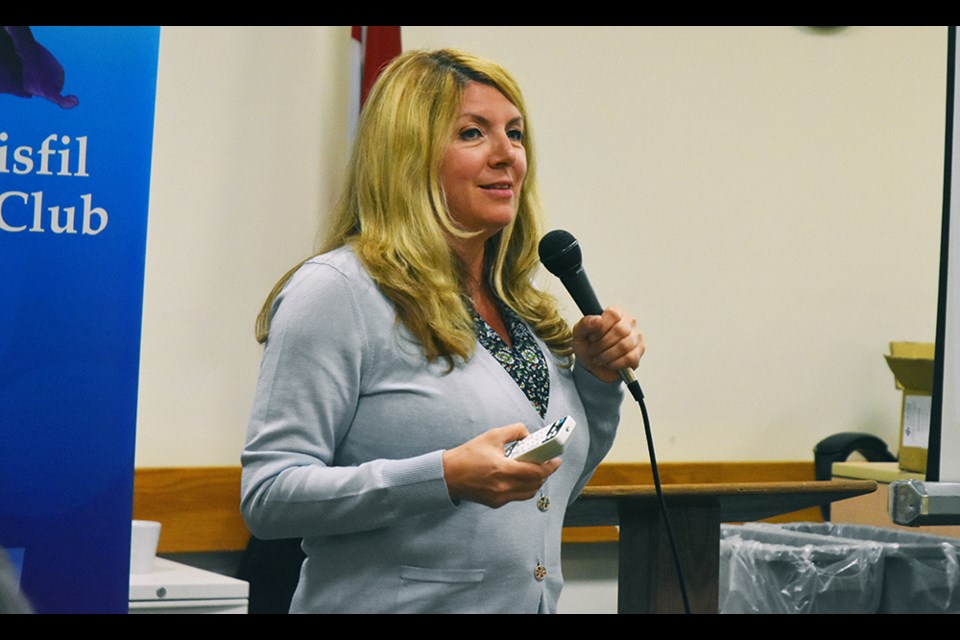Every enthusiastic gardener has had it happen: a bumper harvest that is both a blessing and a curse.
After running out of canning jars, filling every shelf, and giving away zucchini squash to every neighbour and relative, nature’s bounty still overflows.
Julia Dimakos, known as The Gardening Girl, offered gardeners at the Innisfil Garden Club a whole harvest of ideas for storing and preserving fruits and vegetables to last through the winter months.
Dimakos, from Mono, is a gardener, blogger, photographer and backyard “chicken keeper.” She shares her passion for gardening online, Facebook, Twitter and Instagram – and in person, talking to gardening groups.
Her solution to an overabundance of fresh produce? Proper storage.
“If you don’t put it in the right storage, it will ripen. It won’t last long!” Dimakos said. “Stop that maturity.”
For those lucky enough to have a cold room or root cellar, it can be easier – but anyone can transform a dark closet in an unheated bedroom into storage space, with the right setup. All that is needed is shelving, wire mesh baskets, wooden boxes, newspaper, and fine or play sand, “a great way to store some root vegetables.”
Leeks, carrots and beets will remain crispy if stored in sand, Dimakos said. Just cut off the green tops of carrots and all but 2.5 centimetres of the beet tops. As for potatoes, sand helps ensure they avoid exposure to light.
“If potatoes are in they light, they’ll go green,” she warned. “If they go green, they’re toxic and you can’t eat them.”
Onions, shallots and garlic can be stored dry; squash and pumpkin can be stored in the dark on a shelf. Just make sure the squash don't touch and there is plenty of air flow. Use the thin-skinned summer squash first. Winter squash, like Hubbard, have a thicker peel and can last until March.
Cabbage can also be left on a shelf. Just check periodically, and peel away any black or moldy leaves.
Other crops – like apples and green tomatoes – can be placed in a single layer on newspaper, to last for months. Again, she said, check regularly and remove any bad or rotting fruit.
Some things – like peppers and eggplants – need refrigeration, and Dimakos provided tips on storage in the fridge to extend shelf life.
Lettuce not lasting more than a couple of days in the fridge? Rinse completely in ice water to eliminate any dirt, separate the leaves and spin dry, then store in zipper bags, making sure to leave air in the bag.
“It will last two weeks,” Dimakos said. “The air is the key.”
For those items than can’t be stored fresh or refrigerated, she had other solutions: freezing or drying.
Some vegetables need to be blanched – dipped in boiling water for a brief period of time, then rinsed in ice water to stop the cooking process – before being frozen, to stop the enzymes that otherwise will change the taste; others, like fresh corn and tomatoes, don’t need the extra step.
Freezing is a simple alternative, especially for crops like ripe tomatoes that otherwise need to be processed.
“In 2017, I had 50-something (tomato) plants, a lot of varieties, a bumper crop,” said Dimakos. That’s when she discovered that ripe tomatoes could be frozen whole. When defrosted, “the skin slides off”, and the fruit can be used in cooking, in stews and soups.
Freezing is also an ideal way to store herbs and chives. Chop and store in containers in the freezer – or in a tablespoon of water, in ice cube trays. The resulting “cubes” preserve the fresh taste of the herbs, for cooking.
What about zucchini, that over-generous garden staple? Dimakos recommended grating the zucchini into a large bowl, pressing out the water, and then freezing – perfect for future baking needs – or cutting into chunks, blanching and freezing.
As for strawberries and raspberries, the secret to perfectly preserved frozen fruit is to wash, dry, and lay them in a single layer on a cookie sheet or parchment paper to freeze, only bagging them up once they are frozen.
“Or freeze them in the ice cube tray,” she suggested. “Use them as ice cubes instead of ice, to flavour your water.”
Freezing, drying, proper storage – it all can ensure “you’re not throwing away food,” said Dimakos. “Be creative!”
As Dimakos shared her tips, the judges were looking at the 65 entries in the June Flower Show, at the Churchill Community Centre. Thirteen exhibitors placed entries in the floral arrangements, and categories that included iris, peony, and other summer perennials and annuals.
Best Iris trophy was awarded to went to Debbie Hogg; Best Peony trophy to Jan Drybrough.
Best in Show (Design A) went to Jenni Murrell, for her Hogarth design “Seduction.” Design B was won by Jan Drybrough, for her "Father’s Day" arrangement.
Judges’ Choice went to the flowering branch entered by Marsha Thomas, who also won a first for her “Something Found” arrangement, using a recycled container.
The next meeting of the Innisfil Garden Club will be July 8 at 7:30 p.m., at the Churchill Community Centre, when Miriam Goldberger of Wildflower Farm will speak about taming wildflowers.
And coming up on June 27: The Bond Head-Bradford Garden Club meets at the Danube Seniors Leisure Centre, 715 Simcoe Rd. in Bradford West Gwillimbury, to hear speaker Sherry Morrow talk about natural plant defences in the garden. The meeting starts at 7:30 p.m. and includes a flower show for members.



